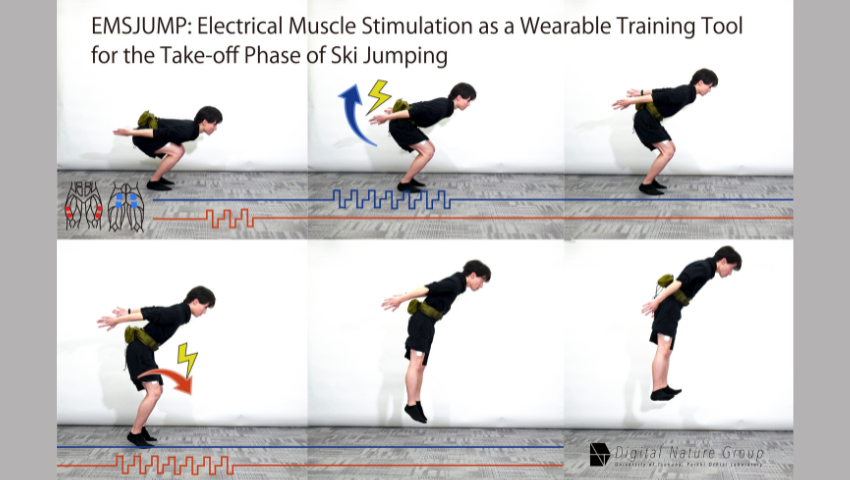Image Credit: Copyright (c) 2024 Shon Nakamura, Digital Nature Group.
“EMSJUMP: Electrical Muscle Stimulation as a Wearable Training Tool for Take-off Phase of Ski Jumping” was inspired by researcher Shon Nakamura’s experience as a competitive ski jumper. Find out what tools were used to develop this research and experiments, and get a glimpse at how athletes can use it to prepare and visualize their muscle movements during a ski jump take-off phase. Read on to learn more about “EMSJUMP”.
SIGGRAPH: Summarize what an EMS system is. What inspired you to research this, especially as it relates to ski jumping?
Shon Nakamura (SN): Electrical Muscle Stimulation (EMS) involves using electrical currents to cause muscle contractions. This method is used in tactile feedback in VR and is increasingly applied in sports training to enhance performance and aid in motor learning. The EMS system in this study is designed to target specific muscles, such as the buttocks and thighs to improve the take-off phase of ski jumping by enhancing muscle engagement and coordination.
The inspiration for this research came from my experience as a competitive ski jumper. I was curious if a computer-assisted solution could address the critical challenge in ski jumping, where a momentary movement can make or break a jump.
SIGGRAPH: Explain some of the tools or techniques that were used in the creation and execution of this system.
SN: The EMS system comprises EMS generators, a microcomputer, a signal control circuit, and electrode pads placed on the gluteus maximus and vastus lateralis muscles. The system is lightweight and wearable, allowing athletes to perform imitation jumps (dry land training) with EMS assistance. Motion capture technology was used to analyze the impact of EMS on jumping kinematics. The characteristics of the EMS pattern were revealed by user surveys using a simple EMS pattern, and there is room for exploratory improvements in the EMS pattern.
SIGGRAPH: Tell us about the two experiments you conducted. What was the user study in training like?
SN: The first experiment involved electrical stimulation in conjunction with squat jumps in general participants. The results showed that the peak angular velocity of the knee joint improved, and that jumping with EMS felt easier, higher, and faster.
In the second experiment, four competitive ski jumpers trained with the system and were interviewed about their physical experiences and sensations.
The EMS facilitated more effective recruitment of the gluteus maximus, resulting in prolonged muscle exertion and heightened awareness. One participant, in particular, struggled with mastering the take-off phase and expressed the belief that concurrent training with EMS could potentially accelerate the learning of muscle coordination and control.
SIGGRAPH: What problems does your EMS system solve? How do you envision it being used in the future?
SN: Ski jumpers face limitations due to physical strength, location constraints, and the need for careful attention to injuries.
The EMS system addresses the difficulty of acquiring and mastering the complex take-off movements in ski jumping. By providing EMS, the system helps athletes better understand and internalize the correct muscle engagement and timing, leading to improved performance.
This system is intended for use in warm-ups, helping athletes visualize and prepare their muscle movements during the take-off phase.
SIGGRAPH: Share with us how you developed your Poster. Did you experience any challenges in your research? If yes, how did you overcome the challenges?
SN: This project was developed as part of my thesis and submitted as a poster.
The primary challenge was exploring body knowledge and the sensory aspects of movement, making it difficult to formulate research questions and objective examination methods. We overcame these challenges by immersing ourselves in actual competition scenes, recalling sensations and movements during take-off, and conducting semi-structured interviews with ski jumpers.
SIGGRAPH: What are you most looking forward to when you present your Poster research at SIGGRAPH 2024?
SN: Presenting this research at SIGGRAPH 2024 is an exciting opportunity to showcase the potential of EMS in enhancing the understanding and communication of bodily sensations in sports. I look forward to interacting with other researchers, receiving feedback, and exploring possibilities to further enhance and improve this research!
There’s no better place to discover more about this research than among the mountains of Denver at SIGGRAPH 2024. Register now so you don’t miss your chance to get firsthand access to new research like “EMSJUMP.”

Shon Nakamura is a master’s student in the informatics degree program at the University of Tsukuba.

Tatsuki Fushimi, Ph.D., is an assistant professor in mechanical engineering at the University of Tsukuba.

Yoichi Ochiai, Ph.D., is an associate professor in applied computer science at the University of Tsukuba.



